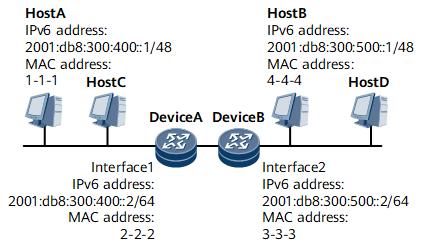Configuring Routed Proxy ND
Routed proxy ND can be deployed if two hosts are on the same network segment but different physical networks and the gateway connecting to the two hosts are configured with two different IP addresses.
Context
If hosts that need to communicate are on the same network segment but different physical networks and the gateway connected to the hosts are configured with different IP addresses, enable routed proxy ND on the interfaces connecting the router and hosts.
To address this problem, enable routed ND proxy on Device A's interface 1 and Device B's interface 2.
Procedure
- Run system-view
The system view is displayed.
- Run interface interface-type interface-number
The interface view is displayed.
- Run ipv6 enable
IPv6 is enabled on the interface.
- Run ipv6 address { ipv6-address prefix-length | ipv6-address/prefix-length }
A global unicast address is configured for the interface.
- Run ipv6 nd proxy route enable
Routed ND proxy is enabled.

Proxy ND cannot be enabled on an interface configured with a CGA address. Otherwise, the replied NA packets that carry the CGA/RSA option may be discarded.
Multiple types of proxy ND can be configured in the interface view. The priorities of these proxy ND types are as follows in descending order: any proxy ND > intra-VLAN proxy ND/inter-VLAN proxy ND/local proxy ND > routed proxy ND.
- Run commit
The configuration is committed.
